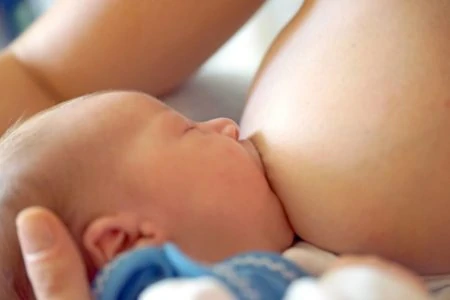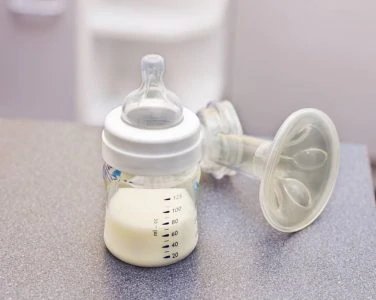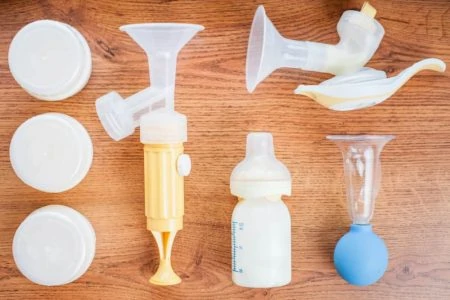Does your newborn seem like a bottomless pit? Or maybe they barely seem to graze during feedings? Figuring out if your baby is eating enough is one of the top stressors for new parents.
If only your little one could talk and tell you when they are full or need a top-up. Since they can’t, you have to become a detective.
Understanding newborn appetites helps you read those subtle cues. Once you crack the code, you will feel much more confident about feeding your baby.
Key Takeaways
- Newborns have tiny stomachs and fast metabolism, requiring feeds every 2 to 3 hours (8 to 12 times daily).
- Hunger cues include rooting (moving head side to side), sucking on hands, and smacking lips; crying is a late sign.
- Signs of fullness include relaxing their hands (open palms), slowing down, unlatching, or turning away.
- Track wet diapers (6+ daily) and weight gain to ensure your baby is getting enough nutrition.
How Often Will My Newborn Eat?
Your newborn will likely want to eat about every two to three hours. They are the masters of mini-meals. While they eat frequently, they don’t consume much in one sitting.
Mom's Tip
If your baby is formula-fed, you can do some quick math. Multiply your baby’s weight by 2.5 to see how many ounces they should consume each day. For example, a 7-pound baby would need about 17.5 ounces of formula in a 24-hour period. Most breastfed babies eat around 20 to 30 ounces a day.
generally, your newborn should not go longer than four to five hours without a feeding.
Why Do Newborns Feed Often?
Newborns need to eat often because their stomachs are incredibly small. To visualize it, experts often compare a baby’s stomach size to fruit or marbles:
- Day 1: Size of a cherry (5-7ml).
- Day 3: Size of a walnut (22-27ml).
- Day 7: Size of an apricot (45-60ml).
- Day 30: Size of a large egg (80-150ml).
Because that capacity is small, it empties quickly.
Breastfed babies tend to eat more often than formula-fed babies because breast milk digests rapidly. Researchers found that a newborn’s stomach capacity is about 20 milliliters (0.6 ounces), and it takes about an hour to digest this amount. This fits perfectly with a baby’s one-hour sleep cycle (1).
Formula takes longer to break down, so a formula-fed baby may stay full slightly longer and not want to eat as frequently (2).
Is My Baby Hungry?
If your baby is hungry, they will try to tell you. Crying is actually a late sign of hunger. Ideally, you want to catch the early signs before the tears start.
Look for these hunger cues:
- Rooting: Moving their head from side to side seeking a nipple.
- Mouthing: Constantly opening their mouth or smacking lips.
- Hand sucking: Putting fists or fingers in their mouth.
- Puckering: Shaping lips to indicate sucking.
- Tongue action: Sticking out their tongue.
- Seeking: Nuzzling against the breast or chest.
Your baby might do some of these things for comfort or exploration, but you should always offer a feeding first to see if hunger is the culprit (3).
Is My Baby Full?
Just as they signal hunger, babies also signal when they are done. Force-feeding a full baby can lead to fussiness and unnecessary spit-up.
Watch for these signs of satiety:
- Relaxed hands: Fists turn into open palms.
- Slowing down: Sucking becomes sporadic or stops.
- Rejection: Spitting out the nipple or turning away.
- Body language: Arching back or pushing away.
- Sleepiness: Falling asleep and unlatching.
If your baby does these things once, they might just need to burp. Try burping them and offering the breast or bottle again. If they still refuse or turn away, the meal is over.
Breastfed babies will often fall asleep at the breast, and it can be hard to know if you should unlatch them. Often, when you try to take them off the breast, they start sucking again. If your baby begins actively swallowing again after starting to suck, then they may still be hungry. Otherwise, don’t feel bad about taking them off the breast.
Editor's Note:
Michelle Roth, BA, IBCLCIs My Baby Getting Enough?
It can be stressful to gauge intake, especially with breastfeeding since you can’t see the ounces disappearing.
You will typically have a pediatrician appointment a few days after birth. The doctor will check your baby’s weight. It is normal for newborns to lose a little weight initially, but they should regain their birth weight within 10 to 14 days. As long as the weight curve is trending up, they are eating enough.
While it’s normal for your baby to lose a little weight in the first few days, the doctor will expect them to gain about 0.5 ounces to 1 ounce per day. Your baby should be back to their birth weight by 10 to 14 days.
Editor's Note:
Michelle Roth, BA, IBCLCIf you have questions about latching or frequency, this appointment is the perfect time to ask.
Here are the key signs your baby is well-fed:
- Wet diapers: Six to eight heavy, wet diapers a day.
- Dirty diapers: At least three bowel movements per day (often mustard-yellow and seedy for breastfed babies).
- Alertness: Active and alert moments when awake.
- Satisfaction: Seems relaxed and “milk drunk” after feeds.
If your baby seems constantly dissatisfied or fussy after a feeding, they may not be transferring enough milk.
For breastfeeding moms, rely on how your body feels. Your breasts should feel fuller before feedings and softer afterward. You should also hear audible swallows during the feed.
If you are concerned, seek the help of a trained breastfeeding professional, like a board-certified lactation consultant (IBCLC).
Another option is to pump your breastmilk and give your baby a bottle. This allows you to measure exactly how much they are drinking. This is typically only recommended if you are separated from your baby or if weight gain is a serious concern.
What Are Cluster Feedings?
Just when you think you have a schedule down, your baby might throw you a curveball. Sometimes babies go longer periods between feedings and then want to eat constantly for a few hours. This is called cluster feeding.
Cluster feeding usually occurs in the late afternoon or evening (the “witching hour”) and is totally normal.
When a baby does this, it is often followed by a longer sleep stretch. They are essentially “tanking up” for the night.
This behavior is most common in breastfed babies. They might feed for a few minutes, pull off, fuss, and want to feed again. This can last for hours and feels exhausting.
If this happens, don’t panic. It usually does not mean you have low milk supply. It is a normal developmental phase (4).
Should I Wake My Baby for Feedings?
In the first few weeks, newborns are sleepy and might snooze right through a mealtime.
Because their tummies are so small, they cannot store enough energy to go long periods without food.
If you are breastfeeding and your newborn sleeps for more than three hours, you should wake them to feed. This keeps them hydrated and protects your milk supply. A formula-fed newborn can go about four hours but should be awakened after that (5).
Once your baby has regained their birth weight (usually by two weeks), most doctors give the green light to let them sleep until they wake up hungry.
Always double-check with your pediatrician before you stop waking your baby for feeds. Every baby is different, and some may need those extra calories for a little longer.
Age-By-Age Eating Guide
Your baby undergoes massive changes in the first year. Their feeding patterns will shift from frequent liquid snacks to larger meals and eventually solids.
Here is a general timeline of what to expect.
Birth to 1 Month
The first month is survival mode. You and your baby are learning this new dance together. Expect it to feel like you are feeding constantly.
Intake Guide
Establish on-demand feeding. Watch the baby, not the clock. Frequent feeding helps establish your milk supply and ensures your baby gets the comfort and calories they need.
1 Month to 3 Months
By now, the fog is lifting slightly. Your baby’s stomach has grown, meaning they can hold more milk and go a little longer between feeds.
At this stage, babies typically consume 4 to 5 ounces per feeding. You might notice a slightly more predictable pattern emerging, though growth spurts will still disrupt things occasionally.
From 1 month to 6 months of age, breastfed babies eat approximately 25 ounces per day. If your baby still breastfeeds 10 times per day, then they’re eating about 2.5 ounces at a time. If they nurse only five times per day, then they’re likely eating about 5 ounces at a time.
Editor's Note:
Michelle Roth, BA, IBCLCIf you are breastfeeding, your supply should be regulating. Your breasts might not feel as engorged as they did in the early weeks; this is normal and doesn’t mean you’re losing milk.
3 Months to 6 Months
Your baby is becoming more social and easily distracted. They might pop off the breast or bottle to look around at a noise.
Intake Guide
Some parents are tempted to start solids now to help the baby sleep longer. However, health organizations recommend waiting until around 6 months. Your baby gets all necessary nutrition from breast milk or formula.
If your baby suddenly wants to eat all the time again, it is likely a growth spurt. These are common around 3 months, 4 months, and 6 months. Feed on demand, and it will pass.
6 Months to 12 Months
Happy half-birthday! This is the exciting milestone where solids come into play.
You can start introducing solids at 6 months, but milk remains the primary source of nutrition. Think of food as “fun” and exploration at this stage.
Signs your baby is ready for solids include:
- Sitting up: Able to stay in a sitting position with minimal support.
- Head control: Holding their head steady.
- Coordination: ability to pick up food and bring it to their mouth.
- Interest: Watching you eat and reaching for your food.
Foods to avoid initially:
- Honey (botulism risk).
- Whole nuts (choking hazard).
- Cow’s milk as a drink (hard to digest).
- Large chunks of raw vegetables or fruit.
Intake Guide
Start with single-ingredient foods to monitor for allergies. Gradually increase texture and variety as your baby gets the hang of chewing and swallowing (7).
Keep In Mind
All babies are unique. The ounces and hours listed here are averages, not laws. If your baby is happy, growing, and meeting milestones, don’t stress over the numbers.
With bottle feeding, be careful not to overfeed. If your baby pushes the bottle away, respect that signal. If they drain the bottle and look for more, offer a little more.
Always trust your gut. If you feel something isn’t right with your baby’s eating habits, call your pediatrician.
FAQs
The Bottom Line
Learning your baby’s feeding cues is a skill that takes time. In the beginning, it might feel like you are just guessing, and that is okay.
Before long, you will know the difference between a “hungry cry” and a “tired cry.” You will know exactly when they need a snack and when they are stuffed.
If your newborn seems to be eating constantly, take a deep breath; it is normal and temporary. As long as they are making plenty of wet diapers and gaining weight, you are doing a great job.









